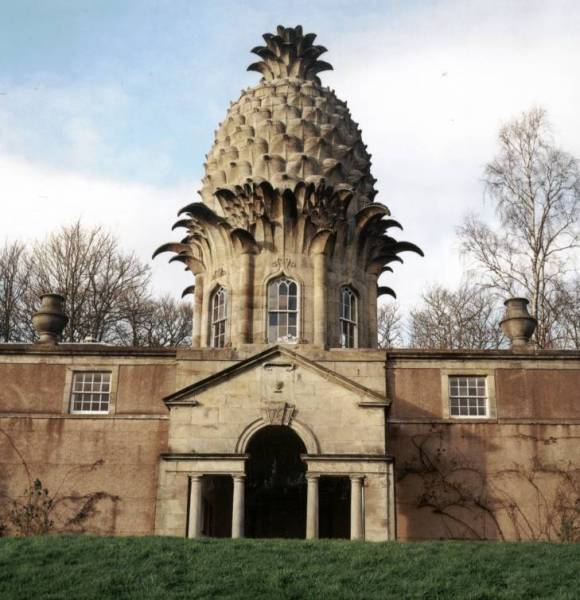Dunmore

The Pineapple (photograph by Ronnie Blackadder)
The Pineapple is one of Scotland’s most famous follies. It is a huge stone replica of the fruit, beautifully carved to reproduce all the features of the real thing. It sits on top of a garden pavilion erected in 1761 by John Murray, the 4th Earl of Dunmore, and stands some 45 feet above ground level on the south slope and 37 feet on the North. The pineapple part was probably added around 1777 when the Earl returned to Scotland after serving as Governor of the colonies of New York and Virginia. On the east coast of the American colonies the pineapple was a symbol of welcome and often the planters from the West Indies, who had big mansions in New York and New England, would place a real pineapple on their gate post as a sign that they were home and ready to receive visitors. Murray returned to the Americas after the War of Independence as Governor of the Bahamas where pineapples were a major product. It is just possible that the stone Pineapple was erected during or after his time there which would place it in the late 1780s or early 90s.
The estate of Dunmore was acquired by John Murray in 1754 as a purchase from the Elphinstones. He was from a Perthshire family closely related to the Marquis of Atholl from Blair Castle. The name Dunmore came from their Perthshire estates and was transferred to the new properties in Stirlingshire. The village of Elphinstone Pans was renamed Dunmore and was rebuilt as a model village in the mid-19th century by one of John Murray’s descendants.
The designer of the pineapple has never been identified though a number of names have been suggested including Robert Mylne, a brilliant architect with connections to the family, William Chambers, the architect of Kew Gardens and Abraham Swan, a designer and wood carver with Blair Castle links and considerable experience of designing dome structures. However there is no direct evidence and these designers make no reference to the project in their correspondence or work diaries. The same is true of the builders. It may be that the designers and masons were Italian and left no available record in this country. Some people have suggested that the family and possibly the designers were rather ashamed of the extravagant folly which was more to do with the vanity of one man than to any attempt to advance architecture.
Pineapples were certainly grown at Dunmore. The south facing wall is hollow and had a fairly sophisticated heating system pumping hot air through the cavities. This along with sloping glass and a mixture of horse manure and tanner’s bark created the necessary temperature to produce the tropical fruit in cold Scotland. The urns on the wall head were chimney pots. Pineapple was a rare and exotic treat in the 18th century and those who had the fruit were regarded as very wealthy indeed. Dunmore provided supplies to Holyrood House and other stately homes in central Scotland. The Dunmore family sold the estates in 1911 and the Pineapple and the buildings fell into disrepair. In 1973 it was given to the National Trust for Scotland and beautifully restored for them by the Landmark Trust who now use it as a holiday property.
Ian Scott (2005)
